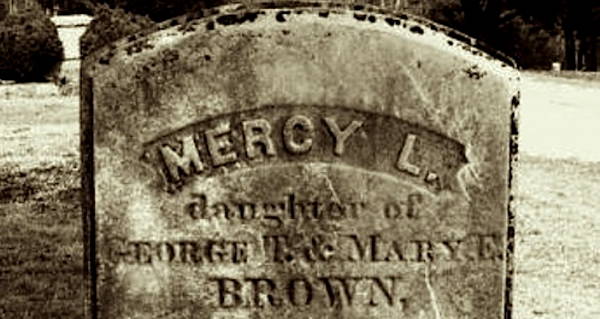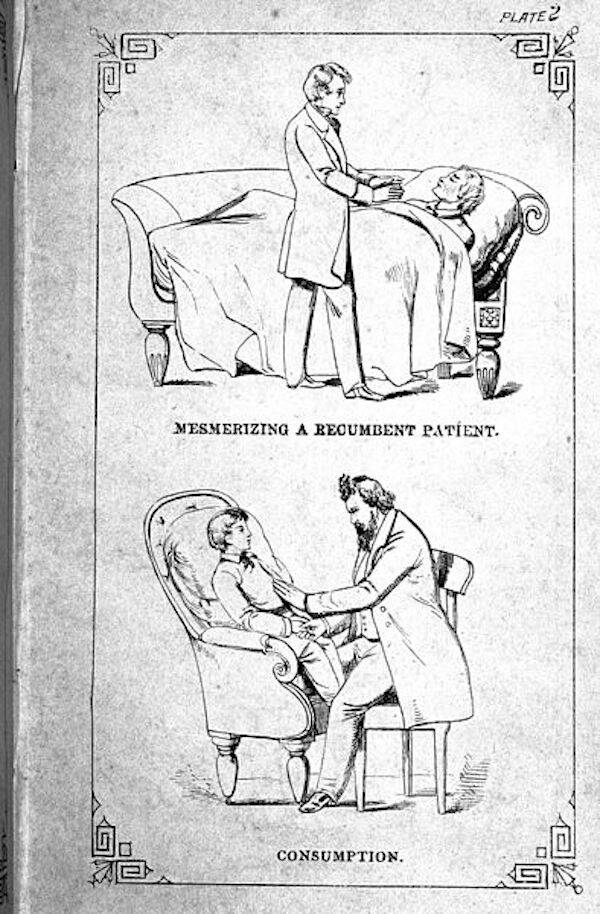
When Mercy Brown’s family started dying off one by one, the town blamed her — even though she’d been dead for months.

FlickrGravestone of Mercy Brown.
In 1892, tuberculosis was the leading cause of death in the United States. Then known as “consumption,” its symptoms included fatigue, night sweats, and the coughing up of white phlegm or even foamy blood.
There was no cure or reliable treatment for tuberculosis. Physicians often recommended that a patient affected by the disease should “rest, eat well, and exercise outdoors.” Of course, these home remedies were rarely successful. People with active tuberculosis had an 80 percent chance of dying from the illness.
The terror surrounding such a gruesome death helps explain the madness that befell the small town of Exeter, Rhode Island at the end of the 19th century. Residents began to fear a “vampire” named Mercy Brown was causing consumption-related deaths in the town — even though she was already dead from that same disease.

Wikimedia CommonsIllustration of mesmerism (aka hypnotism), a common early treatment of tuberculosis.
It all started when a farmer named George Brown lost his wife, Mary Eliza, to tuberculosis in 1884. Two years after the death of his wife, his oldest daughter died of the same illness.
Before long, tragedy would strike the Brown family again. As the family members died one by one, people began to suspect that the reason was something far more sinister than a disease.
The Mercy Brown “Vampire” Incident
The rest of George Brown’s family appeared to be in good health until his son, Edwin, became seriously ill in 1891. He retreated to Colorado Springs in the hopes that he would recover in the better climate. However, he returned to Exeter in 1892 in an even worse state.
Within the same year, Edwin’s sister, Mercy Lena Brown, died from tuberculosis when she was just 19 years old. And with Edwin deteriorating rapidly, his father began to grow increasingly desperate.
Meanwhile, several concerned townspeople kept telling George Brown about an old folk tale. The superstition claims that “…by some unexplained and unreasonable way in some part of the deceased relative’s body live flesh and blood might be found, which is supposed to feed on the living who are in feeble health.”
Basically, the myth claims that when members of the same family waste away from consumption, it might be because one of the deceased is draining the life force from their living relatives.
As a local newspaper reported:
Mr. Brown did not place much credence in the old-time theory, and resisted their importunities until Wednesday, when the bodies of the wife and two daughters were exhumed and an examination had under the direction of Harold Metcalf, M.D., of Wickford.

Matt/FlickrThe crypt where Mercy Brown was likely interred.
Indeed, on the morning of March 17, 1892, a doctor and some locals exhumed the bodies of each family member who had died of tuberculosis. They found skeletons in the graves of Brown’s wife and eldest daughter.
However, the doctor found that the nine-week-old remains of Mercy Brown looked startlingly normal and un-decayed. Furthermore, blood was found in Mercy Brown’s heart and liver. This seemed to confirm the local fears that Mercy Brown was some kind of vampire who had been sucking the life from her living relatives.
What Happened To Mercy Brown After Her Death?
The doctor tried to explain to the townspeople that Mercy Brown’s preserved state was not unusual. After all, she’d been buried during the cold winter months. Nevertheless, superstitious locals insisted on removing both her heart and liver and burning them before reburying her.
The ashes were then mixed with water and fed to Edwin. Unfortunately, this supernatural concoction did not cure him as people had hoped. Edwin died a mere two months later.

FlickrAn 1896 article from the Boston Daily Globe that describes how prevalent fears about vampires had become in Rhode Island around the time of the Mercy Brown vampire incident.
Such practices of digging up and burning the deceased over fears of vampire-like creatures were not uncommon in many Western countries until the early 20th century. But while the Mercy Brown case was far from an isolated incident, her exhumation came at the end of an era for these vampire-inspired rituals.
The Last New England Vampire
While Mercy Brown had a very short life, we can assume her legacy as the “Last New England Vampire” will live on forever thanks to stories passed down over the years.
Her surviving relatives reportedly saved local newspaper clippings in family scrapbooks and often discussed the story on Decoration Day, when the town’s residents decorated local cemeteries.
Today, Mercy Brown’s gravesite is popular with sightseers and curious visitors, who often leave gifts behind such as jewelry and plastic vampire teeth. Once, there was even a note that read, “You go girl.”
Clearly, none of that was happening during the vampire scare of the late 19th century.
Even though German scientist Robert Koch had discovered the bacteria that caused tuberculosis in 1882, germ theory only began to take hold a decade later as the contagion was better understood. Infection rates then began to go down as hygiene and nutrition improved.

Wikimedia CommonsGraphic showing mortality rates for tuberculosis in the United States.
Until then, people resorted to pointing fingers at alleged vampires like Mercy Brown — even when they were no longer alive to defend themselves.